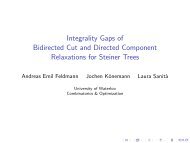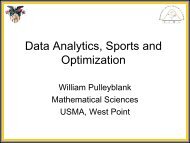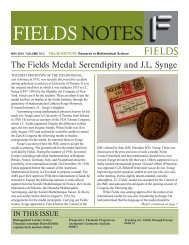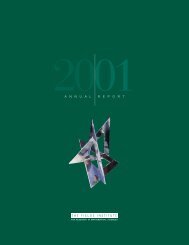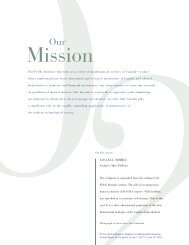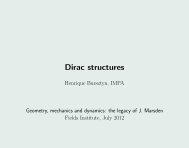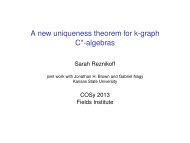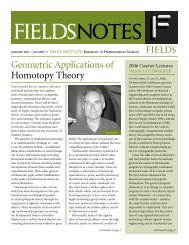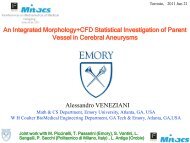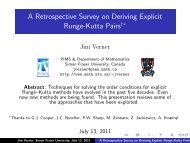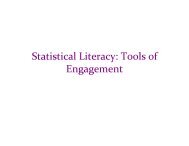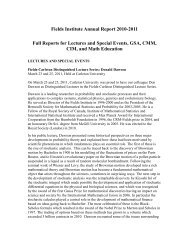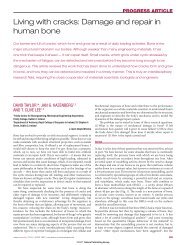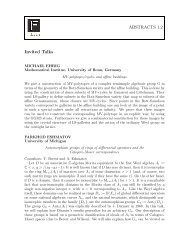SCIENTIFIC ACTIVITIES - Fields Institute - University of Toronto
SCIENTIFIC ACTIVITIES - Fields Institute - University of Toronto
SCIENTIFIC ACTIVITIES - Fields Institute - University of Toronto
You also want an ePaper? Increase the reach of your titles
YUMPU automatically turns print PDFs into web optimized ePapers that Google loves.
Richard Cerezo: From my understanding<br />
<strong>of</strong> the lecture, you characterized cell<br />
motility by its activity with three proteins.<br />
Leah Keshet: That was one aspect <strong>of</strong> a<br />
bigger project in which the three proteins<br />
play a major role, this is absolutely true.<br />
When I give this lecture to biologists, I<br />
tend not to do it quite in the same order…<br />
Since I am giving the talk at the <strong>Fields</strong><br />
<strong>Institute</strong> I wanted to have a centerpiece<br />
which was more mathematical.<br />
RC: Are you a biologist or mathematician<br />
by training, or both?<br />
Siv Sivaloganathan: Her mother was a<br />
pure mathematician and her father was a<br />
biologist, so it was inevitable that she was…<br />
LK: …stuck in between.<br />
RC: I guess that comes across when you<br />
have to tailor your talks to different<br />
audiences.<br />
LK: I try to, although you sometimes get<br />
the opposite attitude and some people<br />
say that to be in a field like this, you need<br />
to be able to sit in two chairs, and you<br />
need to have a very big bottom, because<br />
biologists will say, ‘This is completely too<br />
simplified’ and there is nothing biological<br />
here. And mathematicians will come along<br />
and say, ‘This is too s<strong>of</strong>t, there is nothing<br />
mathematically interesting here.’ So it’s<br />
tricky.<br />
SS: When you’re looking at a problem<br />
that is essentially biological, how do<br />
you go about thinking ‘what’s the crux<br />
<strong>of</strong> the mathematical problem?’ How<br />
do you go about formulating a problem<br />
mathematically?<br />
LK: Well it’s not trivial. It took many<br />
years before we got to even asking the right<br />
questions. We were stumped for a while<br />
at the point where we saw, ‘these are the<br />
three proteins, and these are the reactions.<br />
We’ve simulated them but we don’t get<br />
polarization. What’s going on here? Why<br />
don’t we get what we want?’ To begin to<br />
see what was happening took a long time.<br />
To begin to formulate a simpler problem<br />
that we could pursue analytically took even<br />
more time. It’s been a total <strong>of</strong> seven or<br />
eight years from when we began thinking<br />
about these proteins.<br />
SS: Would you say that apart from<br />
experience, it’s a whole universe <strong>of</strong> things<br />
outside the realm <strong>of</strong> mathematics that you<br />
need to feel through to get a handle on the<br />
problem?<br />
LK: For the first five or six years, a lot<br />
<strong>of</strong> the work is reading the literature and<br />
figuring out what it means, rather than<br />
having a biologist to work with directly.<br />
This is because biologists rarely see the<br />
value <strong>of</strong> models. The biologists who have<br />
these values are rare and it takes a while for<br />
us to build up enough <strong>of</strong> a background to<br />
publish. I have collaborations with Condilis<br />
in New York, which arose because I gave<br />
a similar talk in Minnesota and he was one<br />
<strong>of</strong> the people in the audience. He could<br />
see that there was some value in those<br />
directions.<br />
RC: Was this approach to the problem out<br />
<strong>of</strong> necessity or was this something that you<br />
were trained during your PhD?<br />
LK: I think it’s more a matter <strong>of</strong> luck.<br />
That is, having the right people come<br />
together at the right time. So when I began<br />
thinking about this, I had a postdoc Stan<br />
Moray [...] and he was a person who already<br />
had these two dimensional simulations for<br />
moving cell platforms—not so much as for<br />
many cells interacting with each other, but<br />
he could immediately see that this could be<br />
done. While some students were working<br />
out the biochemistry, we could then go to<br />
them and say, ‘Here’s what we found,’ and<br />
he could go then and make 2D simulations.<br />
If we had to do everything from scratch, it<br />
would have taken a long time.<br />
RC: For the future generation <strong>of</strong> math<br />
biologists, what attitude should we foster?<br />
Since this is a highly non-traditional field<br />
in mathematics.<br />
LK: The good thing is that the field has<br />
become more central and nowadays,<br />
biologists typically have to show some<br />
type <strong>of</strong> modelling component in their<br />
grant proposals. They cannot simply<br />
apply for NIH or NSF funding without<br />
this balance. They have to show that they<br />
have some way <strong>of</strong> taking that data from<br />
their experiments and making sense <strong>of</strong><br />
it by working with theorists. Therefore,<br />
they have much more motivation to be<br />
connected to young people who’ve got<br />
quantitative techniques. So I think it’s<br />
important both to get the good math<br />
background, which means PDEs, ODEs,<br />
numerical simulation, a bit <strong>of</strong> computer<br />
programming, knowing how to use<br />
MATLAB, as well as taking the necessary<br />
background courses in biology that you’re<br />
interested in like immunology <strong>of</strong> cell<br />
biology in my case, and then being very<br />
open to talking to and finding people in<br />
those fields to talk to.<br />
SS: Because in many ways, biology up<br />
until now has been just observation and<br />
acquiring <strong>of</strong> lots <strong>of</strong> data. But trying to do<br />
mathematics with objects that are not in<br />
your chemical equations is something that<br />
is just slowly sinking in.<br />
RC: In what way, if any, did Pr<strong>of</strong>essor<br />
Lee Segal influence your work, your<br />
approach, and your philosophy?<br />
LK: Good question. I think first <strong>of</strong> all<br />
that he was a great applied mathematician.<br />
And I have to say that, despite all his<br />
good intentions, he did not get me all<br />
excited about asymptotic analysis. But<br />
I did appreciate its usefulness, so other<br />
people working with me deal with those<br />
things. He had a way <strong>of</strong> taking problems<br />
and saying, ‘How can we simplify this as a<br />
first cut? How can we take something very<br />
complicated and try and write down what<br />
are the key things that we’ll go after as a<br />
first version? Once we understand that,<br />
we’ll add extra details.’ He was very good<br />
at that.<br />
[...] there are many scientists in every<br />
area who are extremely possessive and have<br />
the attitude <strong>of</strong> saying ‘this is my idea, this<br />
is how it works’, ‘everybody else is a fool’,<br />
‘this is the only way’. Segal was very much<br />
willing to see all kinds <strong>of</strong> points <strong>of</strong> view and<br />
debate, ‘well this kind <strong>of</strong> model can explain<br />
this, the other kind <strong>of</strong> model is not so good<br />
at explaining that’ and vice versa. He was<br />
known in the field as being a great man,<br />
almost a father figure, and I think that is<br />
really important.<br />
RC: So a human aspect was very<br />
important, as well as his ability to relate<br />
to other people, not only his ability to be<br />
solely a scientist?<br />
LK: To bridge between different<br />
perspectives and not be too put <strong>of</strong>f if<br />
someone thought that ‘no actually, things<br />
work a different way’, to be tolerant <strong>of</strong><br />
different points <strong>of</strong> view and be open.<br />
SS: This is interesting because we<br />
had a workshop a couple <strong>of</strong> weeks ago<br />
on Mathematical Oncology and one<br />
<strong>of</strong> the students <strong>of</strong> Weinberg at MIT<br />
was speaking and I was talking to him<br />
afterwards and he was saying how he got<br />
to work with Weinberg. Weinberg said to<br />
him ‘anybody could be a great scientist, I<br />
want you to be a great human being’ and I<br />
thought that was a wonderful thing to say.<br />
FIELDS INSTITUTE Research in Mathematical Sciences | FIELDSNOTES 19



